Topic 8: Grey Matter
0.0(0)
0.0(0)
Card Sorting
1/253
Earn XP
Description and Tags
Study Analytics
Name | Mastery | Learn | Test | Matching | Spaced |
|---|
No study sessions yet.
254 Terms
1
New cards
NEURONES SPELLING
* It keeps saying that neurone is wrong and it should be spelt as neuron but save my exams and all the other notes spell neurone
2
New cards
What do organisms need to do to survive?
* Respond to changes in internal and external environment
3
New cards
What is stimuli?
* A change in the internal or external environment
4
New cards
What are stimuli detected by?
* Receptor cells
5
New cards
Where are receptor cells located?
* Located in the sense organs
* Nose and eyes
* Can also be found inside body
* Pressure receptors in blood vessels
* Nose and eyes
* Can also be found inside body
* Pressure receptors in blood vessels
6
New cards
What is the job of receptor cells?
* They send signals via either the nervous system (sensory neurone) or the hormonal system to the body’s coordination centres in the brain and spinal chord
7
New cards
Where are the signals sent to after the coordination centres?
* They are sent to the effectors via the relay neurons
* Effectors can be either muscles or glands
* Effectors can be either muscles or glands
8
New cards
Examples of coordination and response
* An arm muscle would respond to a hot surface by contracting to move the hand away
* The pancreas responds to high blood sugar by secreting insulin
* The pancreas responds to high blood sugar by secreting insulin
9
New cards
Nervous system pathway
* Simha’s- Stimuli
* Really- Receptor
* Spicy- Sensory neuron
* Curry- Coordinators
* Makes- Motor neuron
* Everyone- Effectors
* Rave- Response
* Really- Receptor
* Spicy- Sensory neuron
* Curry- Coordinators
* Makes- Motor neuron
* Everyone- Effectors
* Rave- Response
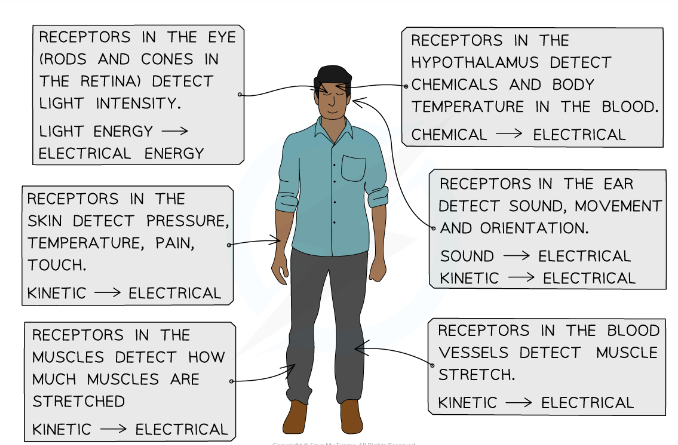
10
New cards
Nervous system pathway in detail
* The nervous system enables the body to detect changes in the environment and brings about appropriate responses to ensure its safety
* Receptor cells detect changes in the environment, or stimuli
* Nerve impulses travel from the receptor cells along sensory neurones to the central nervous system, or CNS
* The CNS acts as a coordinating centre for the impulses that arrive from the receptors, determining which part of the body needs to respond and sending out a new set of impulses along motor neurones
* Motor neurones send impulses to the effectors to bring about a response
* Effectors may be muscles or glands
* Receptor cells detect changes in the environment, or stimuli
* Nerve impulses travel from the receptor cells along sensory neurones to the central nervous system, or CNS
* The CNS acts as a coordinating centre for the impulses that arrive from the receptors, determining which part of the body needs to respond and sending out a new set of impulses along motor neurones
* Motor neurones send impulses to the effectors to bring about a response
* Effectors may be muscles or glands
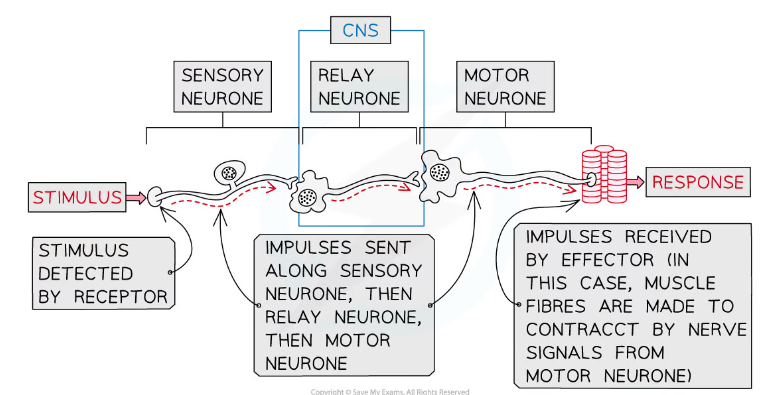
11
New cards
What does the nervous system consist of
* Central nervous system (CNS)
* Brain and Spinal cord
* Peripheral nervous system (PNS)
* All of the nerves in the body
* Brain and Spinal cord
* Peripheral nervous system (PNS)
* All of the nerves in the body
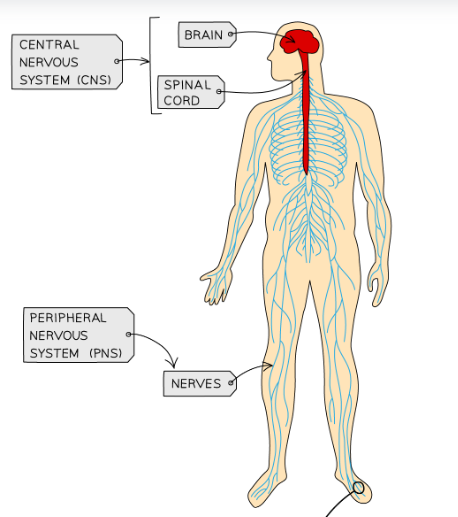
12
New cards
What does the nervous system do?
* It allows for the detection of stimuli in our surroundings and coordinates the body’s response
13
New cards
How is information sent through the nervous system?
* It is sent in the form of electrical impulses that pass along nerve cells known as neurons
* Nerves connect the receptors with the CNS and the CNS with the effectors
* Nerves connect the receptors with the CNS and the CNS with the effectors
14
New cards
What does the CNS do?
* It acts as the central coordinating centre for the impulses that come in from, and are sent out to, any part of the body
* They are the brain and spinal chord
* They are the brain and spinal chord
15
New cards
What are hormones?
* Chemical substances produced by endocrine glands and carried by the blood
* The chemical messengers of the brain
* The chemical messengers of the brain
16
New cards
What is a gland?
* Group of cells specialised to secrete a useful substance
17
New cards
What do hormones do?
* Hormones transmit information from one part of an organism to another and bring about change by altering the activity of one or more specific target organs
* Hormones can leave the blood and bind to specific receptors on the cell surface membranes of target organs
* Hormones can leave the blood and bind to specific receptors on the cell surface membranes of target organs
18
New cards
How do hormones work?
* Hormones are secreted when a gland is stimulated
* They are stimulated by a change in concentration of a specific substance or electrical impulses
* Hormones diffuse into the blood and taken around the body
* They diffuse out everywhere but will bind to specific receptors on target cells
* They trigger a response in the target cells
* They are stimulated by a change in concentration of a specific substance or electrical impulses
* Hormones diffuse into the blood and taken around the body
* They diffuse out everywhere but will bind to specific receptors on target cells
* They trigger a response in the target cells
19
New cards
Endocrine system
* Endocrine glands secrete hormones directly into the blood
* Endocrine glands can be stimulated to secrete hormones by the action of another hormone or by the arrival of a nerve impulse
* Endocrine glands can be stimulated to secrete hormones by the action of another hormone or by the arrival of a nerve impulse
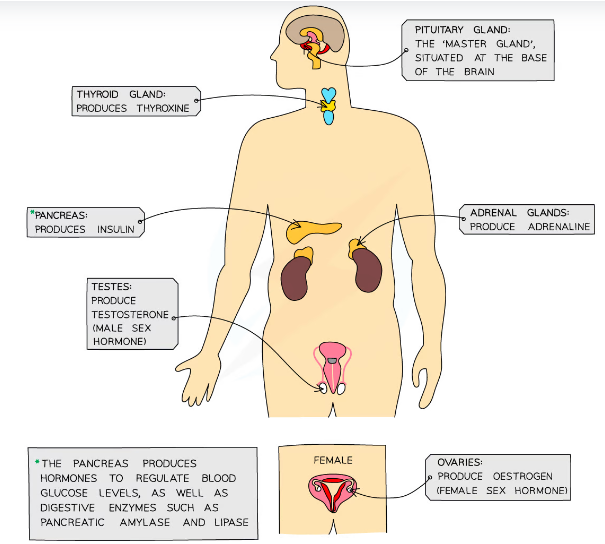
20
New cards
Hormone Pathway
* Stimulus
* Receptor
* Hormone
* Effector
* Receptor
* Hormone
* Effector
21
New cards
Speed of the hormone response
* Slower in action than the nervous impulses
* Therefore used to control functions that do not need instant responses
* Therefore used to control functions that do not need instant responses
22
New cards
Comparison of nervous and hormone system table
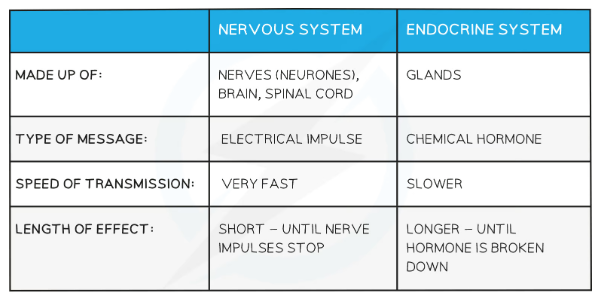
23
New cards
What are neurons?
* Specialised cells of the nervous system which carry electrical impulses around the body
24
New cards
What is a nerve?
* A bundle of nerve cells
25
New cards
Features of all neurons
* Axon
* Axon terminal
* Cell body that contains a nucleus and other cellular structures
* Axon terminal
* Cell body that contains a nucleus and other cellular structures
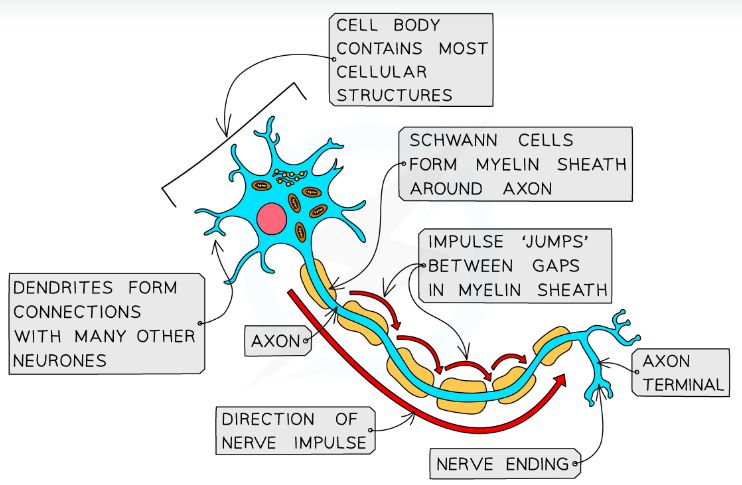
26
New cards
What is the function of the axon?
* Carries nerve impulses away from the cell body
27
New cards
What is the axon terminal?
* The end of the axon
* It has many nerve endings
* Nerve endings at the axon terminals connect to and receive impulses from other neurons, forming a network for easy communication
* It has many nerve endings
* Nerve endings at the axon terminals connect to and receive impulses from other neurons, forming a network for easy communication
28
New cards
What are myelinated neurons?
* Axon is insulated by a fatty layer known as the myelin sheath
29
New cards
What is the myelin sheath made out of and what does it do?
* Made up of specialised cells known as schwann cells which wrap themselves around the axon
* There are uninsulated gaps between the schwann cells called the nodes of ranvier
* This allows the electrical impulses to jump from one node to the next, speeding up impulse transmission
* There are uninsulated gaps between the schwann cells called the nodes of ranvier
* This allows the electrical impulses to jump from one node to the next, speeding up impulse transmission
30
New cards
Non-myelinated neurons
* Axon not insulated by schwann cells
* The impulse travels more slowly as it moves through the entire length of the axon
* The impulse travels more slowly as it moves through the entire length of the axon
31
New cards
Three main types of neurons
* Sensory neurons
* Relay neurons
* Motor neurons
* Relay neurons
* Motor neurons
32
New cards
What does the sensory neuron do?
* carry impulses from receptors to the brain and spinal cord in the CNS
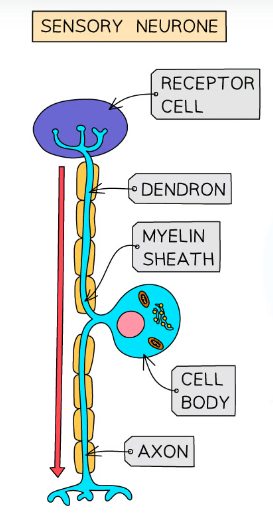
33
New cards
Structure of the sensory neuron
* A cell body that branches off in the middle of the axon and has no dendrites
* The axon terminal is attached to a receptor cell
* The section of neurone that links the axon terminal with the cell body is known as a dendron
* The section of neuron that connects the cell body with the CNS is the axon
* The axon terminal is attached to a receptor cell
* The section of neurone that links the axon terminal with the cell body is known as a dendron
* The section of neuron that connects the cell body with the CNS is the axon

34
New cards
What does the relay neuron do?
* Found entirely within the CNS and connect sensory and motor neurons
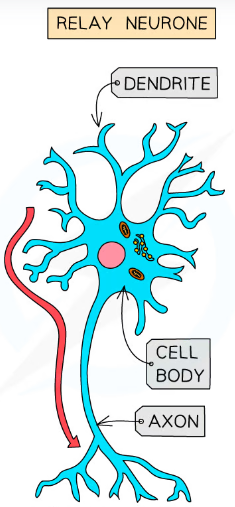
35
New cards
Structure of the relay neuron
* Short neurons with axons and highly branched dendrites
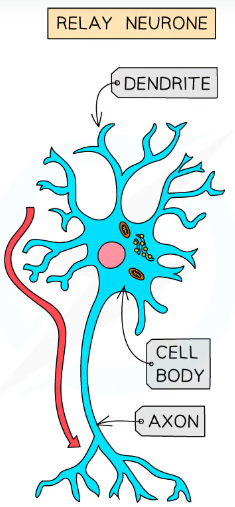
36
New cards
What does the motor neuron do?
* Carry impulses from the CNS to effector muscles or glands
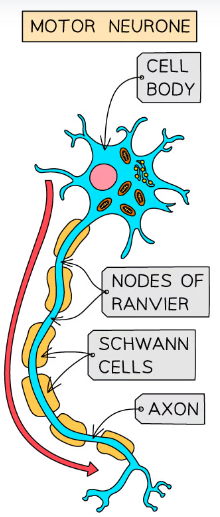
37
New cards
Structure of the motor neuron
* A large cell body at one end that lies within the spinal cord or brain
* Many highly-branched dendrites extending from the cell body, providing many connections with the axon terminals of other neurones
* Many highly-branched dendrites extending from the cell body, providing many connections with the axon terminals of other neurones
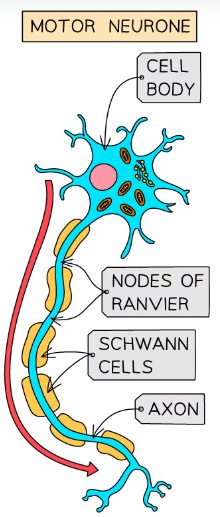
38
New cards
Nervous pathway example: pupil in the eye (stimulus and response)
* Stimulus: Light hitting the retina
* Response: Diameter of the pupil changing
* Response: Diameter of the pupil changing
39
New cards
What is the diameter of the eye controlled by
* Circular muscles: contract to constrict the pupil
* Radial muscles: contract to dilate the pupil
* The muscles work antagonistically
* Radial muscles: contract to dilate the pupil
* The muscles work antagonistically
40
New cards
Pupils in bright light
* Circular muscles contract
* Radial muscles relax
* Pupils constrict to prevent damage to the retina as less light enters the eye
* Parasympathetic
* Radial muscles relax
* Pupils constrict to prevent damage to the retina as less light enters the eye
* Parasympathetic
41
New cards
Pupils in dim light
* Circular muscles relax
* Radial muscles contract
* Pupils dilate to allow more light to enter the eye
* Sympathetic
* Radial muscles contract
* Pupils dilate to allow more light to enter the eye
* Sympathetic
42
New cards
Lens with close object
* lens thickens
* ciliary muscle contracts
* sensory ligaments become slack
* ciliary muscle contracts
* sensory ligaments become slack
43
New cards
Lens with a distant object
* lens thins
* ciliary muscles relax
* sensory ligaments become taut
* ciliary muscles relax
* sensory ligaments become taut
44
New cards
How are nerve pulses transmitted?
* Neurones transmit electrical impulses which travel along the neurone **cell surface membrane** from one end of a neurone to the other
45
New cards
What is an electrical impulse?
* A momentary reversal in the electrical potential difference across the neurone cell surface membrane
46
New cards
Resting potential
* In a resting axon, i.e. one that is not transmitting impulses, the inside of the axon always has a negative electrical potential compared to outside the axon
* The difference in charge between the inside and outside of the neurone is due to different numbers of ions on each side of the neurone cell surface membrane
* When there is a difference in charge across a membrane, the membrane is polarised
* The difference in charge between the inside and outside of the neurone is due to different numbers of ions on each side of the neurone cell surface membrane
* When there is a difference in charge across a membrane, the membrane is polarised
47
New cards
What is the resting potential of the neurone?
* This potential difference, or difference in charge, across the membrane when there are no impulses
* -70mV
* -70mV
48
New cards
What factors contribute to establishing and maintaining resting potential
* The active transport of sodium ions and potassium ions
* A difference in membrane permeability to sodium and potassium ions
* A difference in membrane permeability to sodium and potassium ions
49
New cards
Active transport of sodium and potassium ions
* Carrier proteins called sodium-potassium pumps are present in the cell surface membranes of neurones
* These pumps use ATP to actively transport sodium ions (Na⁺) out of the axon and potassium ions (K⁺) into the axon
* The two types of ions are pumped at an unequal rate; for every 3 sodium ions that are pumped out of the axon, only 2 potassium ions are pumped in
* This creates a concentration gradient across the membrane for both sodium ions and potassium ions
* These pumps use ATP to actively transport sodium ions (Na⁺) out of the axon and potassium ions (K⁺) into the axon
* The two types of ions are pumped at an unequal rate; for every 3 sodium ions that are pumped out of the axon, only 2 potassium ions are pumped in
* This creates a concentration gradient across the membrane for both sodium ions and potassium ions
50
New cards
Difference in membrane permeability to sodium ions and potassium ions
* Because of the concentration gradient generated by the sodium-potassium pumps, both sodium and potassium ions will diffuse back across the membrane
* The neurone cell surface membrane has sodium ion channels and potassium ion channels that allow sodium and potassium ions to move across the membrane by facilitated diffusion
* The neurone membrane is less permeable to sodium ions than potassium ions, so potassium ions inside the neurone can diffuse out at a faster rate than sodium ions can diffuse back in
* So more positive ions on the outside of the neurone than on the inside, generating a negative charge inside the neurone in relation to the outside
* The result of this is that the neurone has a resting membrane potential of around -70 millivolts (mV)
* The neurone cell surface membrane has sodium ion channels and potassium ion channels that allow sodium and potassium ions to move across the membrane by facilitated diffusion
* The neurone membrane is less permeable to sodium ions than potassium ions, so potassium ions inside the neurone can diffuse out at a faster rate than sodium ions can diffuse back in
* So more positive ions on the outside of the neurone than on the inside, generating a negative charge inside the neurone in relation to the outside
* The result of this is that the neurone has a resting membrane potential of around -70 millivolts (mV)
51
New cards
What is an action potential?
* An action potential is the potential electrical difference produced across the axon membrane when a neurone is stimulated e.g. when an environmental stimulus is detected by a receptor cell
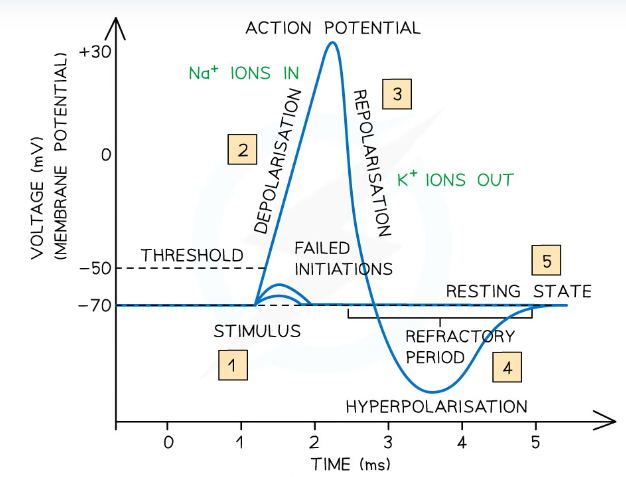
52
New cards
Action potential process
* Once resting potential is reached the neurone membrane is polarised
* To initiate a nerve impulse in a neurone the membrane needs to be depolarised
* The depolarisation of the membrane occurs when an action potential is generated
* Action potentials lead to the reversal of resting potential from around -70 mV to around +30 mV
* Action potentials involve the rapid movement of sodium ions and potassium ions across the membrane of the axon
* To initiate a nerve impulse in a neurone the membrane needs to be depolarised
* The depolarisation of the membrane occurs when an action potential is generated
* Action potentials lead to the reversal of resting potential from around -70 mV to around +30 mV
* Action potentials involve the rapid movement of sodium ions and potassium ions across the membrane of the axon
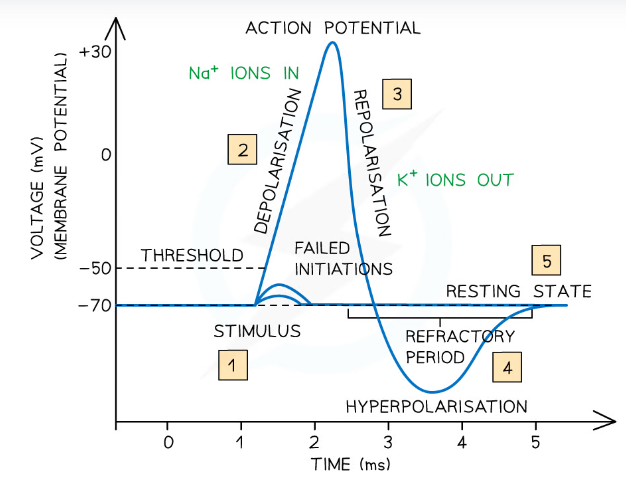
53
New cards
What is depolarisation?
* Depolarisation is the reversal of the electrical potential difference across the membrane
54
New cards
What does voltage gated mean?
* Some of the ion channels in the membrane of a neurone are voltage gated, meaning that they open and close in response to changes in the electrical potential across the membrane
* Voltage gated ion channels are closed when the membrane is at rest, but they are involved in the generation and transmission of action potentials
* Voltage gated ion channels are closed when the membrane is at rest, but they are involved in the generation and transmission of action potentials

55
New cards
Are all neurones voltage gated?
* Not all of the channels in a neurone membrane are voltage gated e.g. some types of potassium ion channels are open when a neurone is at rest to enable potassium ions to diffuse out of the axon and generate a resting potential
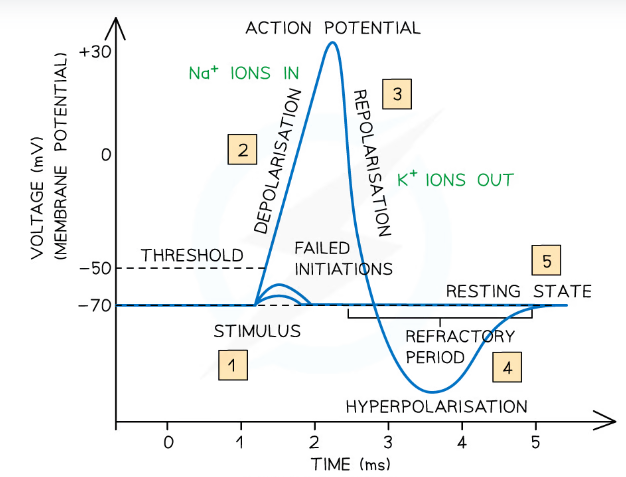
56
New cards
What happens when a nerve is stimulated?
* A small number of sodium ion channels in the axon membrane open
* Sodium ions begin to move into the axon down their concentration gradient
* During resting potential there is a greater concentration of sodium ions outside the axon than inside due to the action of sodium-potassium pumps
* This reduces the potential difference across the axon membrane as the inside of the axon becomes less negative
* If the potential difference reaches around -55 mV, known as the threshold potential, more sodium ion channels open, leading to a further influx of sodium ions
* This second set of sodium ion channels are voltage gated channels
* Note that an action potential is only initiated if the threshold potential is reached
* Once the charge has been reversed from -70 mV to around +30 mV the membrane is said to be depolarised and an action potential has been generated
* Sodium ions begin to move into the axon down their concentration gradient
* During resting potential there is a greater concentration of sodium ions outside the axon than inside due to the action of sodium-potassium pumps
* This reduces the potential difference across the axon membrane as the inside of the axon becomes less negative
* If the potential difference reaches around -55 mV, known as the threshold potential, more sodium ion channels open, leading to a further influx of sodium ions
* This second set of sodium ion channels are voltage gated channels
* Note that an action potential is only initiated if the threshold potential is reached
* Once the charge has been reversed from -70 mV to around +30 mV the membrane is said to be depolarised and an action potential has been generated
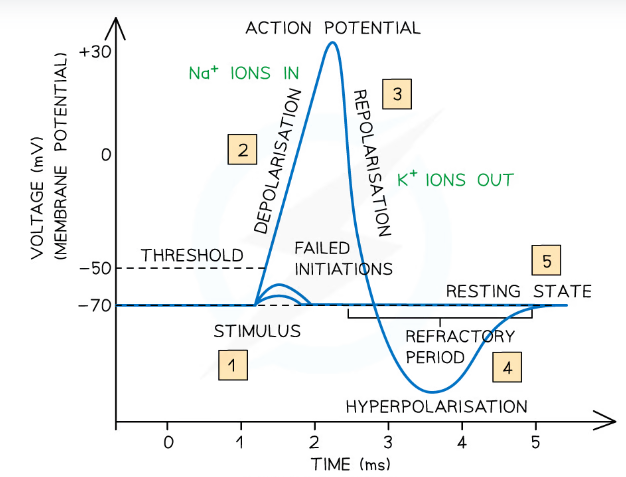
57
New cards
What is the process of repolarisation?
* About 1 millisecond after an action potential is generated all the voltage gated sodium channels in this section of membrane close
* Voltage gated potassium channels in this section of axon membrane now open, allowing the diffusion of potassium ions out of the axon down their concentration gradient
* Remember that the sodium-potassium pumps have not stopped working during the action potential; hence the potassium ion gradient is still present
* This movement of potassium ions causes the inside of the axon to become negatively charged again, a process known as repolarisation
* The voltage gated potassium channels then close, and the sodium-potassium pumps work to restore resting potential
* Voltage gated potassium channels in this section of axon membrane now open, allowing the diffusion of potassium ions out of the axon down their concentration gradient
* Remember that the sodium-potassium pumps have not stopped working during the action potential; hence the potassium ion gradient is still present
* This movement of potassium ions causes the inside of the axon to become negatively charged again, a process known as repolarisation
* The voltage gated potassium channels then close, and the sodium-potassium pumps work to restore resting potential
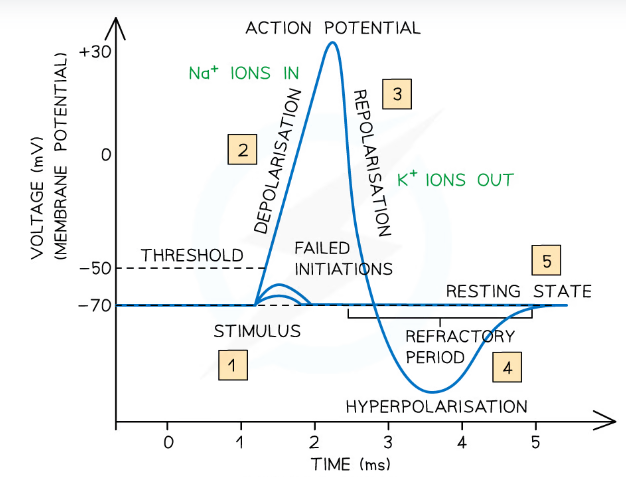
58
New cards
What is hyperpolarisation ?
* Short period during which the membrane potential is more negative than resting potential
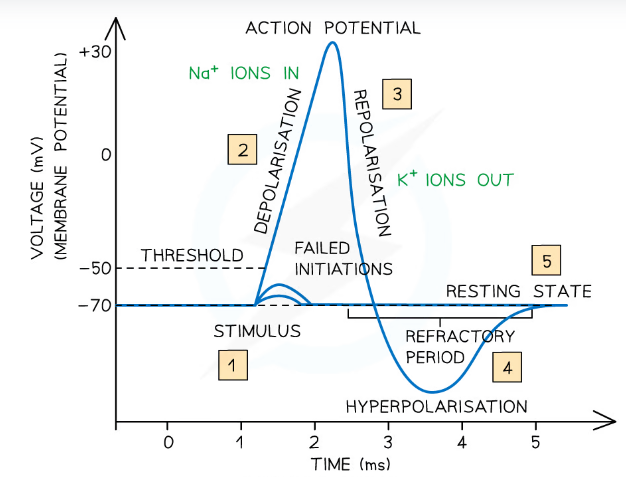
59
New cards
Refractory period
* The period during which the membrane is hyperpolarised
* The membrane is unresponsive to stimulation during the refractory period, so a new action potential cannot be generated at this time
* This makes the action potentials discrete events and means the impulse can only travel in one direction
* This is essential for the successful and efficient transmission of nerve impulses along neurones
* The membrane is unresponsive to stimulation during the refractory period, so a new action potential cannot be generated at this time
* This makes the action potentials discrete events and means the impulse can only travel in one direction
* This is essential for the successful and efficient transmission of nerve impulses along neurones
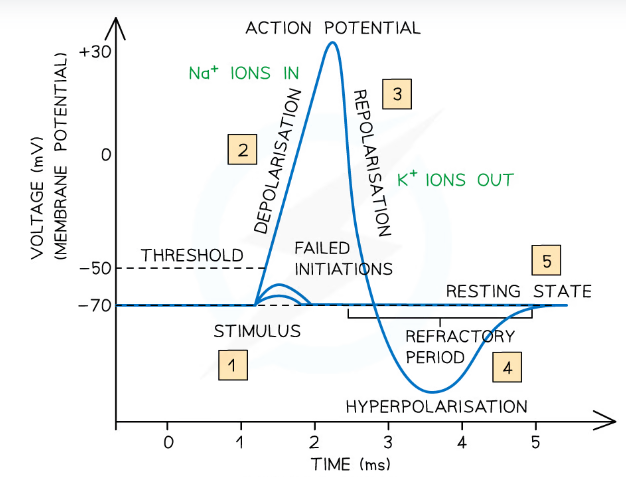
60
New cards
When can the membrane be stimulated
* Once resting potential is restored
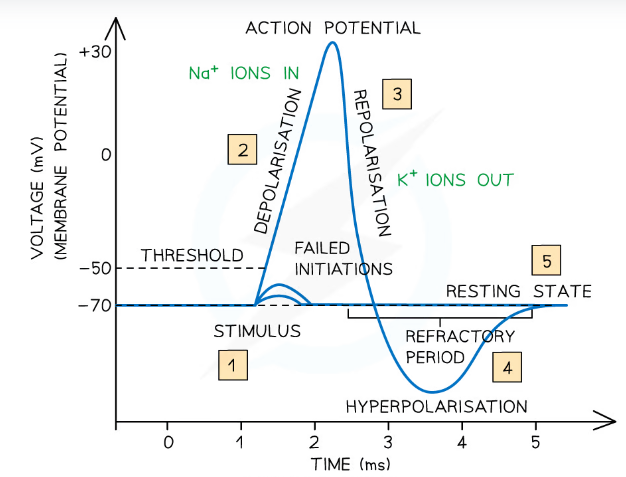
61
New cards
What happens after the action potential
* The action potential generated is propagated (transmitted) along the axon
* The action potential is said to move along the axon in a wave of depolarisation
* In the body, this allows action potentials to begin at one end of an axon and then pass along the entire length of the axon membrane
* The action potential is said to move along the axon in a wave of depolarisation
* In the body, this allows action potentials to begin at one end of an axon and then pass along the entire length of the axon membrane
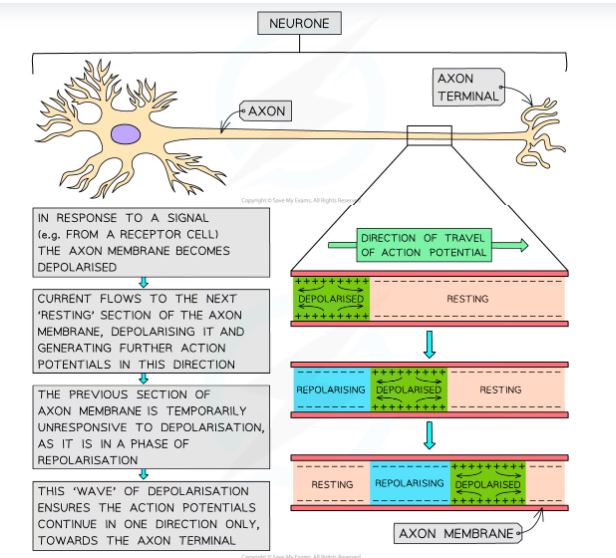
62
New cards
How is the action potential transmitted
* The depolarisation of the membrane at the site of the first action potential causes sodium ions to diffuse along the cytoplasm into the next section of the axon, depolarising the membrane in this new section,
* causing voltage gated sodium channels to open
* Triggers another action potential in this section of the axon membrane
* This process then repeats along the length of the axon
* Any sodium ions that diffuse backwards along the membrane are unable to initiate a new action potential due to the hyperpolarised nature of the membrane in the moments following an action potential
* causing voltage gated sodium channels to open
* Triggers another action potential in this section of the axon membrane
* This process then repeats along the length of the axon
* Any sodium ions that diffuse backwards along the membrane are unable to initiate a new action potential due to the hyperpolarised nature of the membrane in the moments following an action potential
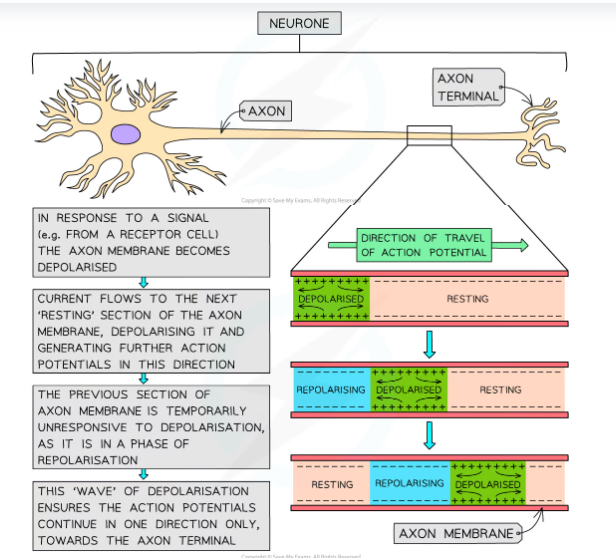
63
New cards
What is the all-or-nothing principle?
* An impulse is only transmitted if the initial stimulus is sufficient to increase the membrane potential above a threshold potential
64
New cards
Why is there no such thing as a small or large action potential?
* If a stimulus is weak only a few sodium ion channels will open and the membrane won’t be sufficiently depolarised to reach the threshold potential; an action potential will not be generated
* If a stimulus is strong enough to raise the membrane potential above the threshold potential then an action potential will be generated
* If a stimulus is strong enough to raise the membrane potential above the threshold potential then an action potential will be generated
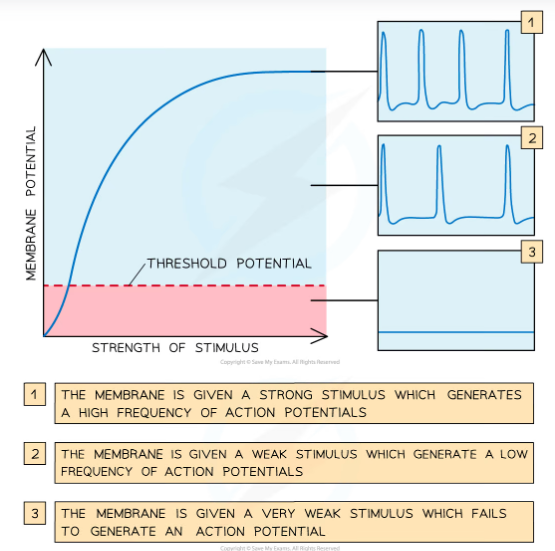
65
New cards
The threshold potential being reached depends on what?
* Number of action potentials arriving at the presynaptic knob
* Many action potentials will cause more neurotransmitter to be released by exocytosis
* A large amount of neurotransmitter will cause many sodium ion channels to open
* Many sodium ion channels opening will allow a large influx of sodium ions, increasing the likelihood of threshold being reached
* Many action potentials will cause more neurotransmitter to be released by exocytosis
* A large amount of neurotransmitter will cause many sodium ion channels to open
* Many sodium ion channels opening will allow a large influx of sodium ions, increasing the likelihood of threshold being reached
66
New cards
How can the size of a stimulus be detected by the brain if there are no small or large action potentials?
* as the intensity of a stimulus increases, the frequency of action potentials transmitted along the neurone increases
* This means that a small stimulus may only lead to one action potential, while a large stimulus may lead to several action potentials in a row
* This means that a small stimulus may only lead to one action potential, while a large stimulus may lead to several action potentials in a row
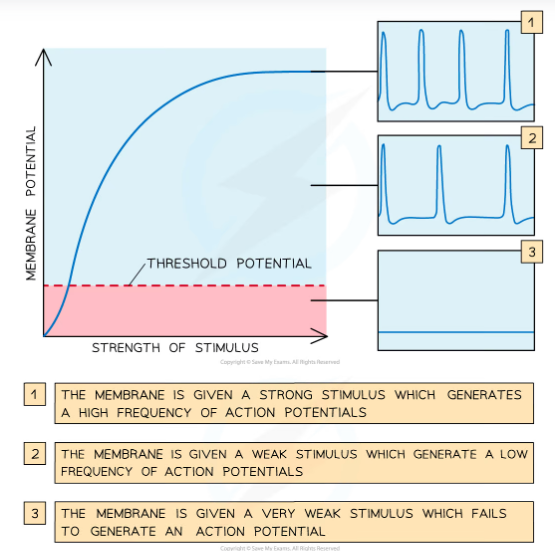
67
New cards
Speed of conduction in unmyelinated neurones
* Sower
* Depolarisation must occur along the whole membrane of the axon
* Depolarisation must occur along the whole membrane of the axon
68
New cards
Where do action potentials occur in a myelinated neurone?
* Only in the nodes of Ranvier
* As depolarisation cannot occur where the axon is insulated by the myelin sheath
* As depolarisation cannot occur where the axon is insulated by the myelin sheath
69
New cards
What is a local current?
* Where sodium ions diffuse along the axon within the Schwann cells and the membrane at the nodes of Ranvier depolarises when the sodium ions arrive
70
New cards
What is saltatory conduction?
* Where the action potential therefore appears to ‘jump’ from one node to the next
* Allows the impulse to travel much faster than in an unmyelinated axon of the same diameter
* Allows the impulse to travel much faster than in an unmyelinated axon of the same diameter
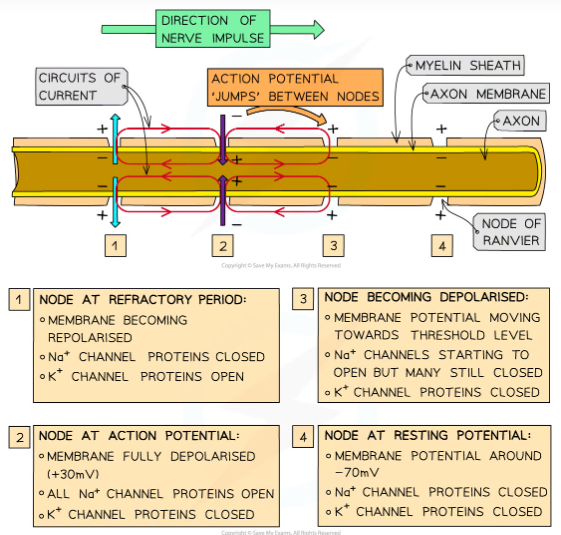
71
New cards
Why is preventing impulse transmission sometimes useful?
* Although transmission of impulses is essential for survival, it is sometimes useful to prevent them (like painkillers)
* Such drugs may bind to sodium ion channels, preventing them from opening and therefore preventing an influx of sodium ions when an axon is stimulated
* Preventing sodium ion influx prevents membrane depolarisation and an action potential cannot be generated
* Such drugs may bind to sodium ion channels, preventing them from opening and therefore preventing an influx of sodium ions when an axon is stimulated
* Preventing sodium ion influx prevents membrane depolarisation and an action potential cannot be generated
72
New cards
What is a synapse?
* Junction between neurones or a neurone and an effector cell
73
New cards
Structure of the synapse?
* A gap between the neurones known as the synaptic cleft
* The neurone before the synapse is known as the presynaptic neurone and has a rounded end known as the synaptic knob
* The neurone after the synapse is known as the postsynaptic neurone
* Nerve impulses are passed across the synaptic cleft by the diffusion of chemicals known as neurotransmitters
* Contained within vesicles in the synaptic knob
* The neurone before the synapse is known as the presynaptic neurone and has a rounded end known as the synaptic knob
* The neurone after the synapse is known as the postsynaptic neurone
* Nerve impulses are passed across the synaptic cleft by the diffusion of chemicals known as neurotransmitters
* Contained within vesicles in the synaptic knob
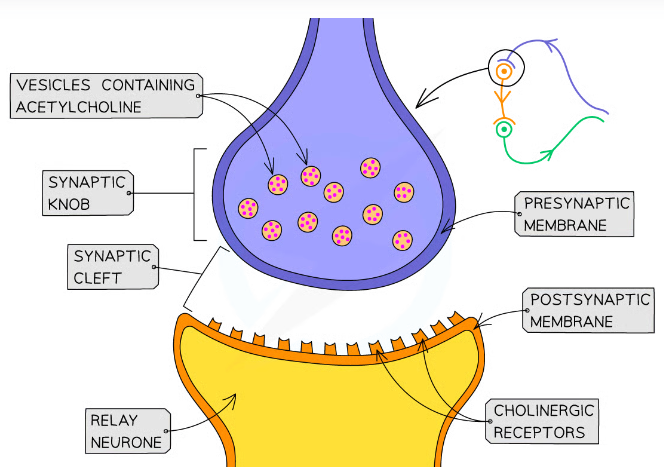
74
New cards
Synaptic transmission process
* When an action potential arrives at the end of the axon of the presynaptic neurone the membrane becomes depolarised, causing voltage gated calcium ion channels to open
* Calcium ions diffuse into the synaptic knob via calcium ion channels in the membrane
* The calcium ions cause vesicles in the synaptic knob to move towards the presynaptic membrane where they fuse with it and release chemical messengers called neurotransmitters into the synaptic cleft by exocytosis
* The neurotransmitters diffuse across the synaptic cleft and bind with receptor molecules on the postsynaptic membrane; this causes associated sodium ion channels on the postsynaptic membrane to open, allowing sodium ions to diffuse into the postsynaptic cell
* If enough neurotransmitter molecules bind with receptors on the postsynaptic membrane then an action potential is generated, which then travels down the axon of the postsynaptic neurone
* The neurotransmitters are then broken down to prevent continued stimulation of the postsynaptic neurone
* Calcium ions diffuse into the synaptic knob via calcium ion channels in the membrane
* The calcium ions cause vesicles in the synaptic knob to move towards the presynaptic membrane where they fuse with it and release chemical messengers called neurotransmitters into the synaptic cleft by exocytosis
* The neurotransmitters diffuse across the synaptic cleft and bind with receptor molecules on the postsynaptic membrane; this causes associated sodium ion channels on the postsynaptic membrane to open, allowing sodium ions to diffuse into the postsynaptic cell
* If enough neurotransmitter molecules bind with receptors on the postsynaptic membrane then an action potential is generated, which then travels down the axon of the postsynaptic neurone
* The neurotransmitters are then broken down to prevent continued stimulation of the postsynaptic neurone
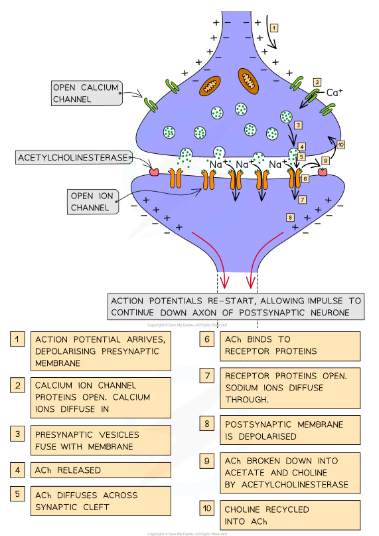
75
New cards
What is undirectionality of impulse transmission?
* Synapses ensure the one-way transmission of impulses
* Impulses can only pass in one direction at synapses because neurotransmitter is released on one side and its receptors are on the other; chemical transmission cannot occur in the opposite direction
* Impulses can only pass in one direction at synapses because neurotransmitter is released on one side and its receptors are on the other; chemical transmission cannot occur in the opposite direction
76
New cards
What is the divergence of nerve impulses?
* One neurone can connect to several other neurones at a synapse, allowing nerve signals to be sent in several directions from a single presynaptic neurone
77
New cards
What is the amplification of nerve impulses by summation?
* When an impulse arrives at a synapse it does not always cause an impulse to be generated in the next neurone; a single impulse that arrives at a synaptic knob may be insufficient to generate an action potential in the post-synaptic neurone
78
New cards
What is summation?
* The effect of multiple impulses can be added together to overcome the threshold potential
79
New cards
What is synaptic convergence?
* Several presynaptic neurones converging to meet a single postsynaptic neurone
* Many action potentials arriving at a postsynaptic knob in quick succession
* Many action potentials arriving at a postsynaptic knob in quick succession
80
New cards
What is the eye?
* A sense organ containing receptors sensitive to light intensity and wavelength
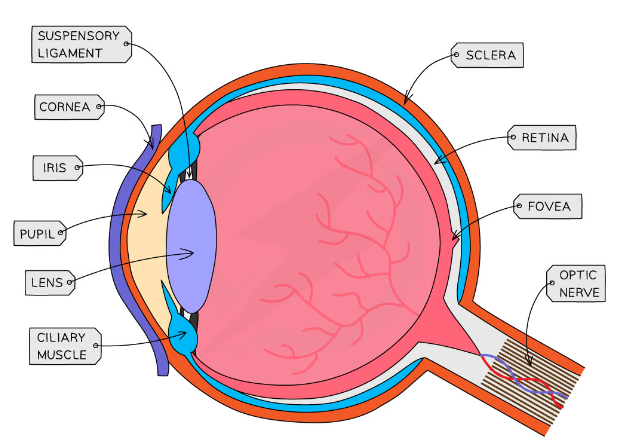
81
New cards
What is a receptor?
* Specialised cells that can generate an electrical impulse in a sensory neurone when stimulated by a particular stimulus
82
New cards
How is light focused on the retina?
* Light enters eye via pupil and is focused on the region of the retina called the forvea
* The amount of light entering the eye controlled by muscles of iris
* Light is focused using the lens, the shape of which is controlled by ciliary muscles attached to the lens by suspensory ligaments
* The muscles change the shape of the lens to allow it to focus light reflected from objects at different distances from the eye
* The fovea contains many light receptors, or photoreceptors
* The amount of light entering the eye controlled by muscles of iris
* Light is focused using the lens, the shape of which is controlled by ciliary muscles attached to the lens by suspensory ligaments
* The muscles change the shape of the lens to allow it to focus light reflected from objects at different distances from the eye
* The fovea contains many light receptors, or photoreceptors
83
New cards
What are the two types of photoreceptors called?
* Rod cells
* Cone cells
* Cone cells
84
New cards
Location and function of rod cells
* Located in outer retina
* Sensitive to light intensity so can detect the presence and brightness of light
* Images generated using information from only rod cells is black and white
* Sensitive to light intensity so can detect the presence and brightness of light
* Images generated using information from only rod cells is black and white
85
New cards
Location and function of cone cells
* Mostly found grouped together in forvea
* Sensitive to different wavelengths of visible light and so detect colour
* Cone cells can be red-sensitive, green-sensitive, or blue-sensitive
* The number of red-, green-, and blue-sensitive cone cells stimulated will determine the colours seen
* Images generated using information from cone cells will be in colour
* Sensitive to different wavelengths of visible light and so detect colour
* Cone cells can be red-sensitive, green-sensitive, or blue-sensitive
* The number of red-, green-, and blue-sensitive cone cells stimulated will determine the colours seen
* Images generated using information from cone cells will be in colour
86
New cards
How are action potentials generated in the photoreceptor transmitted to the brain?
* Through the optic nerve
87
New cards
What is the blind spot?
* The optic nerve leaves the back of the eye from a region known as the blind spot
* The blind spot contains no photoreceptors
* The blind spot contains no photoreceptors
88
New cards
What do photoreceptors do?
* Generate nerve impulses
* Light-sensitive pigments inside the photoreceptors are bleached when light falls on them
* The bleaching of light-sensitive pigments causes a chemical change in the photoreceptor that results in the generation of a nerve impulse
* Light-sensitive pigments inside the photoreceptors are bleached when light falls on them
* The bleaching of light-sensitive pigments causes a chemical change in the photoreceptor that results in the generation of a nerve impulse
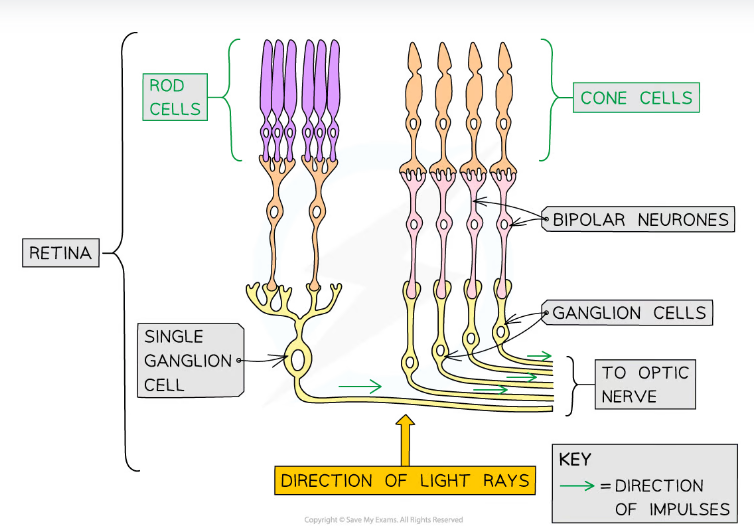
89
New cards
Example of photoreceptor
* Rod cells contain a light-sensitive pigment called rhodopsin
* When light hits rhodopsin it breaks apart into constituent parts retinal and opsin
* The breaking apart of rhodopsin is known as bleaching
* When light hits rhodopsin it breaks apart into constituent parts retinal and opsin
* The breaking apart of rhodopsin is known as bleaching
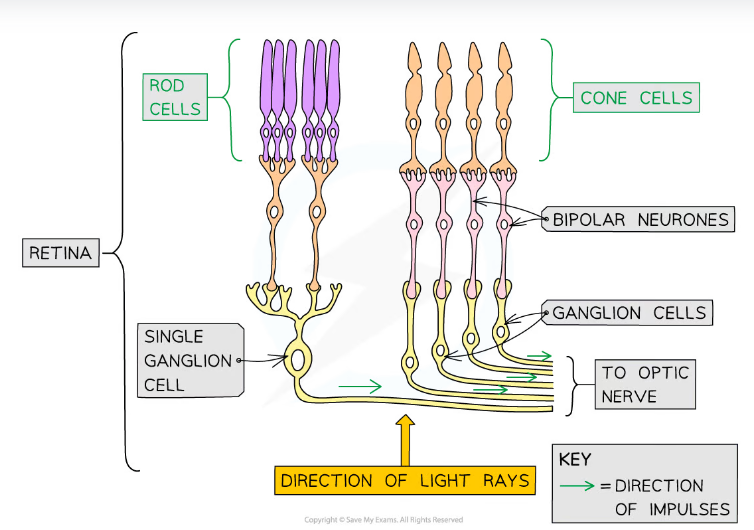
90
New cards
How do nerve impulses travel to the optic nerve?
* Nerve impulses travel along a bipolar neurone to the optic nerve
91
New cards
When do rod cells initiate an action potential?
* When they are hyperpolarised
* Other nerve cells act in the opposite way
* Other nerve cells act in the opposite way
92
New cards
What occurs in the rod cells in the dark?
* Sodium ions are actively pumped out of rod cells, generating a concentration gradient
* Sodium ions (Na+) are positively charged ions, also known as cations
* Sodium ions diffuse back down this concentration gradient into the rod cell via sodium channels
* Sodium channels are also known as cation channels because they allow the movement of positively charged ions
* At this stage there is little difference in charge between the outside and inside of the rod cell, and the cell is depolarised
* In reality the inside of the rod cell is slightly negative in comparison to the outside
* The depolarised rod cell releases neurotransmitters which diffuse across a synapse to a bipolar neurone
* Rather than initiating an action potential in the bipolar neurone this neurotransmitter inhibits the generation of an action potential, preventing a nerve impulse from being sent to the optic nerve
* This neurotransmitter is said to be an inhibitory neurotransmitter
* Sodium ions (Na+) are positively charged ions, also known as cations
* Sodium ions diffuse back down this concentration gradient into the rod cell via sodium channels
* Sodium channels are also known as cation channels because they allow the movement of positively charged ions
* At this stage there is little difference in charge between the outside and inside of the rod cell, and the cell is depolarised
* In reality the inside of the rod cell is slightly negative in comparison to the outside
* The depolarised rod cell releases neurotransmitters which diffuse across a synapse to a bipolar neurone
* Rather than initiating an action potential in the bipolar neurone this neurotransmitter inhibits the generation of an action potential, preventing a nerve impulse from being sent to the optic nerve
* This neurotransmitter is said to be an inhibitory neurotransmitter
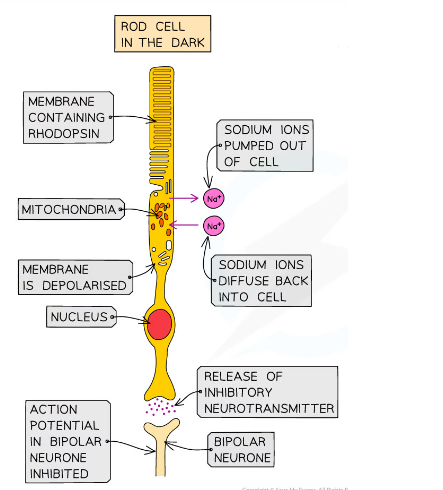
93
New cards
Rod cells in the light
* Light bleaches rhodopsin, causing it to break apart into retinal and opsin
* The bleaching of rhodopsin causes the sodium ion channels in the cell surface membrane of the rod cell to close, preventing sodium ions from diffusing back into the rod cell
* The active transport of sodium ions out of the cell is still taking place, so sodium ions are removed from the cell but not able to return
* The lack of positively charged ions entering the rod cell causes its interior to become more negative until it reaches a hyperpolarised state
* A membrane that is hyperpolarised has a more negative potential difference across it than the resting -70 mV
* The hyperpolarised rod cell stops releasing an inhibitory neurotransmitter, so the generation of an action potential in the neighbouring bipolar neurone is no longer inhibited
* An action potential is generated in the bipolar neurone attached to the rod cell and an impulse is sent to the optic nerve
* The bleaching of rhodopsin causes the sodium ion channels in the cell surface membrane of the rod cell to close, preventing sodium ions from diffusing back into the rod cell
* The active transport of sodium ions out of the cell is still taking place, so sodium ions are removed from the cell but not able to return
* The lack of positively charged ions entering the rod cell causes its interior to become more negative until it reaches a hyperpolarised state
* A membrane that is hyperpolarised has a more negative potential difference across it than the resting -70 mV
* The hyperpolarised rod cell stops releasing an inhibitory neurotransmitter, so the generation of an action potential in the neighbouring bipolar neurone is no longer inhibited
* An action potential is generated in the bipolar neurone attached to the rod cell and an impulse is sent to the optic nerve

94
New cards
How do plants respond to changes in their environment to survive?
* Growing towards light maximises the rate of photosynthesis and therefore glucose production
* Producing harmful or foul-tasting chemicals in response to being eaten by a herbivore reduces the likelihood of being eaten
* Roots growing towards water maximises the plant's ability to gain water
* Producing harmful or foul-tasting chemicals in response to being eaten by a herbivore reduces the likelihood of being eaten
* Roots growing towards water maximises the plant's ability to gain water
95
New cards
Examples of stimuli that plants respond to?
* Light
* Gravity
* Physical objects
* Herbivory
* Water
* Physical touch
* Gravity
* Physical objects
* Herbivory
* Water
* Physical touch
96
New cards
What is a tropism?
* Directional growth response
97
New cards
What is phototropism?
* Growth response to light
98
New cards
Geotropism
* Growth response to gravity
99
New cards
Positive tropism
* Growth towards a stimulus
100
New cards
Negative tropism
* Growth away from a stimulus